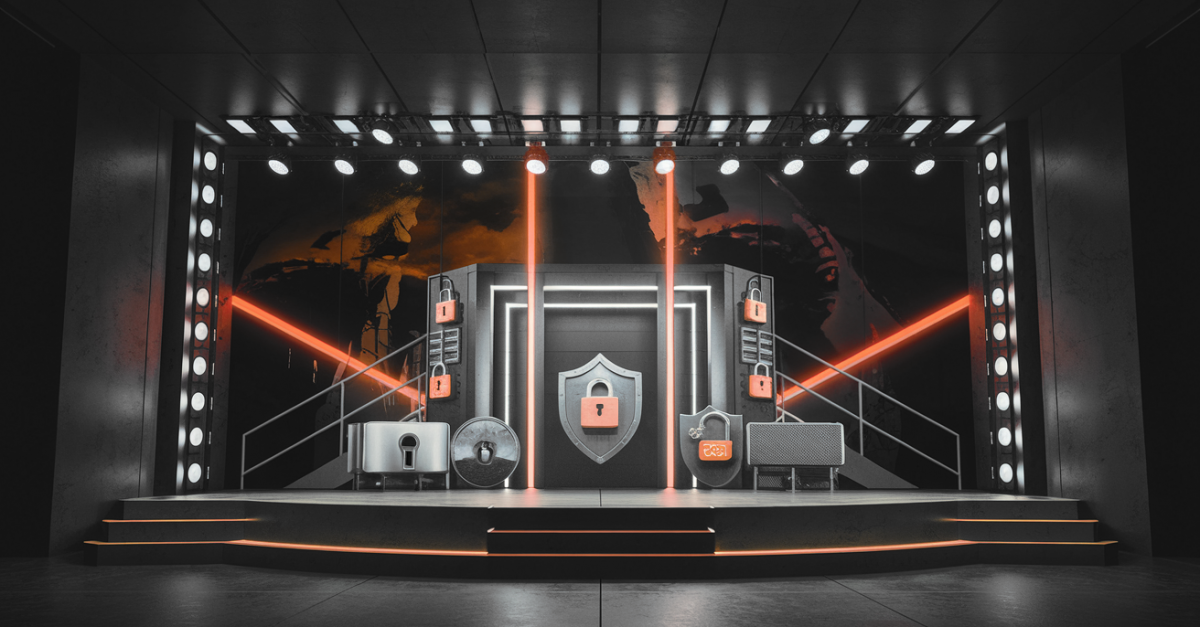Your security budget is bigger than ever. The dashboard is lit up green with “compliant” status indicators. All audit reports look spotless. Yet somehow, breaches still happen, ransomware still gets through, and you’re left wondering how millions in security spending couldn’t prevent what should have been a basic attack.
Welcome to security theatre, the expensive illusion that you’re more protected than you actually are.
The term “security theater” was coined by security expert Bruce Schneier to describe measures that provide the feeling of improved security without actually improving security. While Schneier originally applied this to airport security, the concept has found an uncomfortable home in corporate IT departments worldwide.
The disconnect between security spending and security outcomes is staggering. Research shows that companies deploy an average of 47 different cybersecurity solutions, yet 53% of IT security leaders don’t know if their cybersecurity tools are actually working. Despite an average annual security spend of $18.4 million, less than half of IT experts are confident that data breaches can be stopped with their organization’s current investments.
Unfortunately, many organizations are unknowingly starring in their own security theater production, complete with elaborate costumes (complex security policies), dramatic performances (security awareness training), and an audience (executives) who applaud the show while the real threats slip in through the back door.
The Performance Begins: How Security Theater Takes Hold
Security theater doesn’t start with malicious intent. It begins with the best of intentions: a genuine desire to protect the organization, combined with pressure to demonstrate visible security improvements to stakeholders who may not understand the technical nuances of cybersecurity.
The process typically follows a predictable script. First, there’s an incident or regulatory requirement that demands immediate action. Leadership wants to see results fast. The security team, under pressure to deliver something tangible, implements measures that are highly visible and easily quantifiable. These measures often come with impressive-sounding names, colorful dashboards, and reassuring compliance checkmarks.
The problem is that visibility doesn’t equal effectiveness. A security solution that generates detailed reports and provides clear metrics isn’t necessarily stopping threats. It’s just documenting its own existence.
Consider the organization that implements a sophisticated email security gateway, complete with AI-powered threat detection and real-time reporting. The dashboard shows thousands of threats blocked daily, and executives feel confident about their email security posture. Meanwhile, employees are still getting phished through Teams messages, personal email accounts, and SMS attacks that the expensive email solution doesn’t even monitor.
The security team isn’t lying about the effectiveness of their email gateway. It really is blocking thousands of malicious emails. But the attackers have simply moved to different channels, rendering the solution largely irrelevant to actual security outcomes.

The Most Common Examples of Security Theater
Security theater manifests in countless ways across modern organizations. Here are the most prevalent examples that IT leaders encounter:
1. Password Complexity Requirements That Weaken Security
The classic example: forcing users to create passwords with uppercase letters, lowercase letters, numbers, special characters, and minimum length requirements, then requiring them to change these passwords every 90 days.
This feels like strong security policy. It checks boxes for compliance frameworks. It demonstrates that the organization takes password security seriously.
In reality, these requirements often create weaker security. Users respond by creating predictable patterns (Password123! becomes Password124! three months later), writing passwords down, or reusing slight variations across multiple systems. The complexity requirements feel secure but actually increase the likelihood of compromise.
Organizations implementing these policies often skip the security measure that would actually make a difference: multi-factor authentication. MFA is less visible, harder to audit, and doesn’t generate as many impressive policy documents, but it’s exponentially more effective than complex password requirements.
2. Security Awareness Training That Doesn’t Change Behavior
Monthly phishing simulations with detailed reporting on click-through rates. Mandatory annual security awareness training with completion certificates. Regular security newsletters with the latest threat information.
These programs create extensive documentation of security education efforts. They provide clear metrics (training completion rates, phishing simulation results) that demonstrate organizational commitment to security awareness.
But measuring training completion isn’t the same as measuring behavior change. Organizations often discover that employees who ace their security training still fall for actual phishing attempts, still use weak passwords, and still engage in risky behaviors when they’re in a hurry or under pressure.
The most effective security awareness programs focus on changing specific behaviors in real-world contexts, not on generating training completion statistics.
3. Over-Investment in Security Tools Without Strategy
Organizations often accumulate security tools organically, adding new solutions to address specific threats or requirements without considering how they work together. The result is a complex security stack with overlapping capabilities, coverage gaps, and no clear strategy for how the pieces fit together.
This creates impressive security architecture diagrams and detailed inventories of security capabilities. Each tool generates its own reports and metrics, creating the appearance of comprehensive protection across all attack vectors.
But having more security tools doesn’t automatically mean better security. Multiple tools monitoring the same attack vectors while ignoring others entirely, alert fatigue from overlapping detection systems, and security teams spending more time managing tools than investigating actual threats all reduce overall security effectiveness.
The security theater element comes in when organizations measure security success by the number of security tools deployed rather than the effectiveness of their overall security posture. They invest heavily in adding new capabilities without ensuring those capabilities integrate with existing systems or address actual security gaps.
4. Perimeter Security in a Perimeter-less World
Network firewalls, intrusion detection systems, and network access controls all have their place in a comprehensive security strategy. But many organizations over-invest in perimeter security while under-investing in endpoint and identity protection.
This approach made sense when employees worked in offices, accessed applications through corporate networks, and used company-managed devices. Today’s reality is remote work, cloud applications, personal devices, and network access from coffee shops, home offices, and airport terminals.
Organizations still running perimeter-heavy security architectures often have impressive network security statistics and detailed network monitoring reports. They can demonstrate sophisticated threat detection capabilities and rapid response times for network-based attacks.
But when an employee’s laptop gets compromised at home, or when an attacker uses stolen credentials to access cloud applications directly, the expensive perimeter security infrastructure becomes irrelevant. This is why zero trust architecture is so important.
5. Reactive Security That Misses Proactive Prevention
Many organizations focus heavily on detecting and responding to security incidents after they occur, rather than preventing them from happening in the first place. This approach emphasizes sophisticated monitoring, rapid incident response, and detailed forensic analysis.
These capabilities generate impressive metrics about mean time to detection, incident response efficiency, and threat hunting effectiveness. Security teams can demonstrate their ability to identify, contain, and remediate security incidents quickly and thoroughly.
The security theater element comes in when organizations assume that good incident response equals good security. They invest heavily in detection and response capabilities while neglecting basic security hygiene that would prevent many incidents from occurring.
For example, an organization might have a world-class security operations center that can detect and respond to malware infections within minutes, but still allow users to run with admin rights that make malware infections possible in the first place. The SOC metrics look great, but the organization remains vulnerable to preventable attacks.

Why Smart Organizations Fall for Security Theater
Understanding why security theater is so prevalent requires recognizing the institutional pressures that create it. These aren’t failures of individual judgment but rather systemic issues that affect even the most security-conscious organizations.
The first pressure is the need for immediate visibility. When executives ask “What are we doing about security?” they expect concrete answers with measurable outcomes. Security theater provides both: specific tools and services that can be easily explained and quantified.
Explaining that you’ve implemented a comprehensive security awareness training program with 95% completion rates is much simpler than explaining that you’re working on cultural change initiatives that will reduce risky behavior over time through a combination of policy changes, technology adjustments, and management reinforcement.
The second pressure is risk management through documentation. In the event of a security incident, organizations want to demonstrate that they took reasonable precautions. Having extensive documentation of security measures, training programs, and compliance efforts provides legal and regulatory protection, regardless of their actual effectiveness.
This creates an incentive to implement security measures that are easily documented and audited, even if they’re not the most effective options available.
The third pressure is vendor marketing. Security vendors have every incentive to promote solutions that provide visible results and clear ROI calculations. A solution that prevents attacks invisibly is harder to sell than one that generates detailed reports of threats blocked and incidents prevented.
Vendors aren’t deliberately promoting ineffective solutions, but they naturally promote solutions that are easier to justify to decision-makers who need to demonstrate security spending results.
The Real Cost of Security Theater
Security theater isn’t just ineffective but actively harmful to organizational security in several ways.
The most obvious cost is financial. Security theater diverts budget from effective security measures to measures that feel secure but don’t actually reduce risk. Organizations operating security theater programs often find themselves perpetually increasing security spending while their actual security posture remains unchanged or even deteriorates.
The hidden cost is opportunity cost. Every dollar spent on security theater is a dollar not spent on measures that would actually reduce risk. Every hour spent managing security theater is an hour not spent addressing real vulnerabilities.
But the most dangerous cost is false confidence. Security theater creates the illusion that risks are being addressed, which reduces the urgency around implementing more effective measures. Organizations may delay or avoid necessary security improvements because they believe their current measures are sufficient.
CompTIA’s 2025 State of Cybersecurity report reveals a fundamental disconnect between stated cybersecurity priorities and actual budget allocations, with skill gaps and lack of dedicated budgets now ranking as the primary hurdles to effective security initiatives.
This false confidence can persist until a significant security incident reveals the gap between perceived and actual security. At that point, the organization must not only deal with the immediate incident response but also confront the reality that their security investments weren’t protecting them as expected.
Moving Beyond the Performance
Transitioning from security theater to effective security requires changing how organizations think about security measurement and investment.
Take our Endpoint Privilege Management solution, for example. Removing administrative rights from user endpoints is one of the most effective security measures an organization can implement. It prevents the majority of malware infections, reduces the impact of successful phishing attacks, and eliminates entire categories of attack vectors.
Removing admin rights isn’t loud or flashy; it doesn’t generate colorful dashboards full of blocked threats or detailed reports showing security team heroics. Instead, it quietly prevents thousands of potential security incidents from ever occurring. The success is measured by the absence of problems, not the presence of security activity.
Organizations serious about moving beyond security theater need to embrace that the most successful security measures prevent incidents rather than respond to them. The transition also requires honest assessment of current security measures rather than accepting vendor promises at face value.
Key evaluation criteria include whether security measures address actual attack vectors targeting your industry, whether you can measure business impact beyond technical metrics, and whether your security choices are driven by effectiveness or ease of explanation to executives.
The Security You Need, Not the Security You See
Organizations stuck in security theater mode will keep throwing money at problems that don’t actually exist while the real threats walk right through their defenses. Meanwhile, organizations that focus on boring, effective security measures will quietly prevent most attacks from ever succeeding.
Your security budget is finite. Every dollar spent on theater is a dollar not spent on protection. The question every organization needs to ask is simple: Are you paying for security, or are you paying for the illusion of it?







